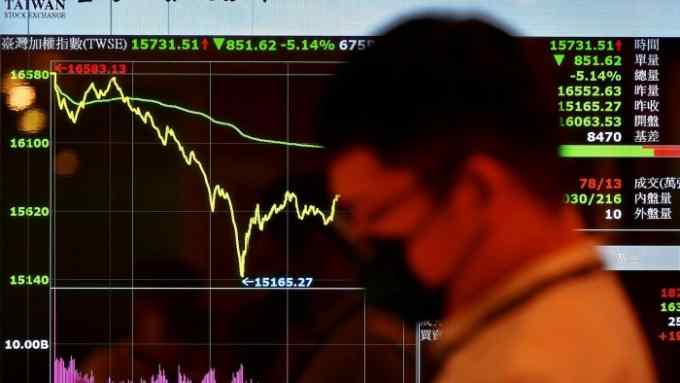Shanghai and South Korea exchanges agree to cross-list ETFs

Simply sign up to the Exchange traded funds myFT Digest -- delivered directly to your inbox.
Interested in ETFs?
Visit our ETF Hub for investor news and education, market updates and analysis and easy-to-use tools to help you select the right ETFs.
Stock exchanges in Shanghai and South Korea have agreed to establish a cross-border exchange traded fund link that will allow ETF providers to sell their products directly to investors in the other market.
Cai Jianchun, general manager of the Shanghai Stock Exchange, and Sohn Byungdoo, chair and chief executive of the Korea Exchange, signed a memorandum of understanding via a video link last week.
“The demand for overseas investment has driven in-depth co-operation between China and South Korea’s capital market industries,” the Shanghai Stock Exchange said in the announcement.
KRX’s Sohn said future co-operation in areas including ETF cross-listing and joint index development would provide investors with greater access to the capital markets of both countries.

This article was previously published by Ignites Asia, a title owned by the FT Group.
“I am highly confident that this MOU will contribute to the fruition of a longstanding co-operative relationship between Korea and China,” he said in a KRX announcement.
The ETF industries in both South Korea and China have been growing rapidly over the past few years.
In South Korea, ETF assets have increased by more than 40 per cent over the past 12 months, from about $37bn to nearly $53bn, according to Morningstar data.
Meanwhile, in China, ETF assets have grown by 34.7 per cent from $93.52bn at the end of March 2020 to $126.01bn at the end of the first quarter this year.
While the plans appear short on detail at this stage, the Shanghai exchange added that the two parties would explore jointly developing related indices, facilitating cross-border investment and co-operation related to the bond market.
It added that both markets would learn from other ETF exchange links that have already been established between other markets, and would try to take advantage of the growing cross-border trade between China and South Korea.
In 2019, China set up an ETF connectivity scheme with Japan after which four Chinese and four Japanese asset managers listed ETFs that invest and trade in each other’s markets. The eight ETFs that kickstarted the scheme attracted Rmb1.5bn ($218m) in assets during the initial fundraising period.
Last year, regulators in mainland China and Hong Kong established a cross-listing master-feeder framework with two pairs of ETFs that are approved to be sold in the respective markets. Under the scheme, four ETF issuers — two in Hong Kong and two in China — formed two separate one-on-one ties for the debut of the new link.
The two schemes appear to have been only moderately successful so far, however.
The eight ETFs sold under the China-Japan ETF connectivity scheme had attracted just $147.8m by the end of March, up from $111.26m at the end of June last year.
Four out of the first eight cross-border ETFs between China and Japan suffered from sizeable outflows, with China Asset Management’s ChinaAMC Nomura Jap-Econ 225 ETF suffering redemptions of $37m between June 2020 and the end of March this year.
Even though the China-Japan ETF scheme was struggling to gain momentum, the Shanghai and Shenzhen stock exchanges, and the Japan exchange approved new ETFs in January.
However, four months on, only three of the second batch of four ETFs have actually been listed, and it appears that one ETF from ICBC Credit Suisse Asset Management has yet to be rolled out on the Tokyo exchange.
The Hong Kong-China ETF master-feeder scheme has had reasonable trading volumes, but perhaps in a sign that the impetus for the programme was a top-down initiative from regulators, no new managers had expressed interest in joining the programme when contacted by Ignites Asia at the end of last year.
The lacklustre performance of the existing schemes raises questions over the future success of South Korea-China plans.
Jackie Choy, director of ETF research for Asia at Morningstar, said that if the new link between South Korea and China was going to be a master-feeder structure, demand might be hindered by “layers of complexities”, such as multiple fees, and the fact that two issuers in two markets need to be paired for any launch.
South Korean investor appetite is also uncertain. ETF investors in South Korea can already gain access to China assets via local ETFs or those listed in other markets using qualified foreign institutional investor quota or the Hong Kong-China stock connect, he added.
Out of more than 450 ETFs listed on the Korean exchange, 15 are investing in China’s onshore market.
Meanwhile, Chinese investors still largely have a home bias and are not familiar with a market like Korea, so ETF issuers in China might not be so enthusiastic to roll out feeders that invest in the Korean market, according to Choy.
*Ignites Asia is a news service published by FT Specialist for professionals working in the asset management industry. It covers everything from new product launches to regulations and industry trends. Trials and subscriptions are available at ignitesasia.com.

Click here to visit the ETF Hub

Comments